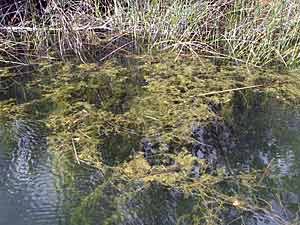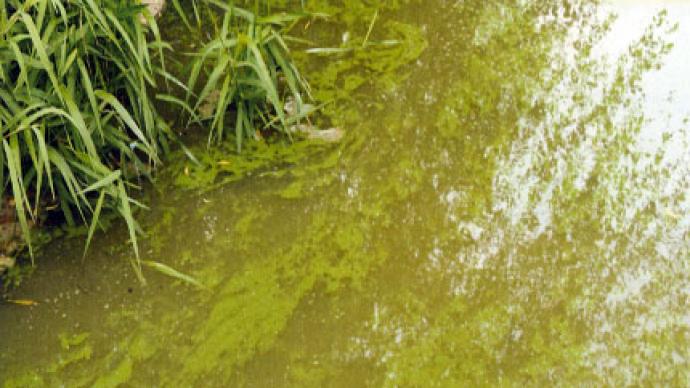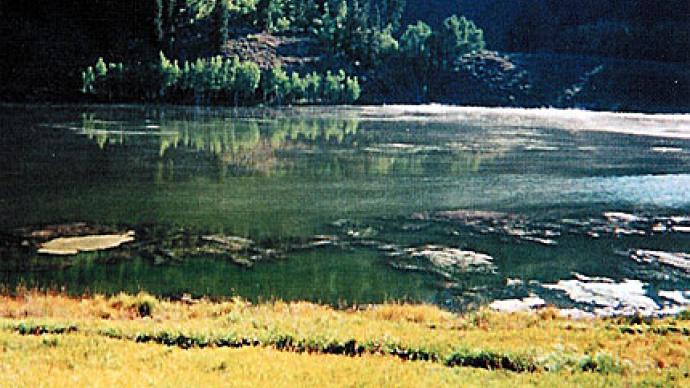
For many years, nuisance algae blooms have been treated with copper compounds, namely copper sulfate products. Metallic copper has proven to be a powerful algaecide, however there are a number of potentially negative side effects when using copper sulfate products.
Indirectly, the use of copper sulfate can actually increase algae's growth and frequency over time. Copper sulfate kills algae the day it is applied (when indirect contact with targeted bloom). Unfortunately, this product quickly falls through the water column, ultimately accumulating on the pond bottom in the form of a heavy metal precipitate. A typical pond bottom consists of sediment and organic matter in the form of fish debris, waterfowl droppings, leaves and other dead vegetation - collectively referred to as detritus. This organic matter contains a fair amount of phosphorus, the nutrient responsible for a majority of all algae growth.
There are two paths this available nutrient can be accounted for -- through an animal cycle or back through a plant/algae cycle. Let's explore the second possibility first...
Following a typical shoreline copper sulfate treatment, surface algae may have been reduced by 70, 80 even 90 percent. Things look great ... on the surface.
On the pond bottom, a heavy metal precipitate in the form of metallic copper has begun. Firstly, copper kills invertebrates. This includes insects and their larvae, crayfish (with high concentrations), the natural (indigenous) bacteria and the expensive bacterial product you may have been adding. By eliminating or greatly reducing these first order consumers, we have inadvertently weakened the food chain and one of the two avenues for phosphorus uptake has been compromised. The phosphorus contained in the detritus, including the algae we have just killed, has no where to go but back into more algae and/or weed production. Unfortunately, it does not end there.
We rely on bacteria and insect larvae to break down the unwanted organics accumulating on the pond bottom. By reducing their numbers, we are effectively decreasing our overall water depth. The shallow water conditions allow sunlight to reach a greater percentage of the pond bottom, further increasing the growing potential of unwanted vegetation.
Furthermore, although the copper sulfate treatment had no negative "contact" effects on our fish population, over time we may notice a decline in our forage fish (fathead minnows for example), poor body condition in our gamefish and an overall reduction in growth rates. Years later, we may decide to dredge the many layers of organic sediment that have been building, only to find no one will accept our tailings due to the heavy metal copper concentrations found in them!
I think we will all agree that the animal cycle is the way to "tie up" and account for unwanted phosphorus concentrations. In a healthy pond, bacteria is feeding on dead organic matter, insects and their larvae are feeding on bacteria and detritus as well. Ultimately, fish feed on these organisms and quite simply the largest fish is the end of the chain. The amount of phosphorus accounted for in the fishery is incredible. On pound of fish matter holds the same amount of phosphorus as 400 pounds of dried algae!
Conversely, one pound of phosphorus can grow up to 1000 pounds of algae! Concentrations as low a 0.03 parts per million of total phosphorus will support an algae bloom.
If you must use an algaecide, strongly recommend using a product with a chelated copper compound. These compounds are also using metallic copper as the active ingredient, but in the chelated forms the copper is combined with other compounds to help prevent the loss of active copper from the water.
Chelated compounds also work at killing algae for up to 14 days, whereas copper sulfate kills only the day it is applied. When used in conjunction with herbicides, these compounds can also enhance aquatic weed treatment performance.
The first scientist to discover, formulate, patent and market such a product was Dr. Bernard Domogalla, a researcher for the Wisconsin Department of Hygiene in the 1950's. Cutrine Plus Algaecide was used in all of Dr. Domogalla's aquatic services and our Wisconsin-based company also uses Cutrine Plus exclusively.
However, following the expiration of the original Cuttine patent, many companies now produce similar chelated compounds, these include: Aquatrine Algaecide, AV-70, Algimycin and K-Tea Algaecide. As with any herbicide/algaecide, be sure to read all label recommendations and consult your local natural resources department for application regulations.
Herbicides and algaecides are but one of many tools in our "aquatic tool box." When used alone, these products are merely band-aids that don't address the true problem. There are many ways reduce aquatic vegetation in your lake or pond, but they must be dealt with at the source. Preventative maintenance tips would include:
- Control nutrient loading - Surface water runoff, especially in the presence of livestock, raises phosphorus and nitrogen levels.
- Introduce aquatic plants that may be less offensive than algae and will not only compete for the same nutrients but also will stabilize bottom sediments and provide habitat.
- Buffer zones around ponds and lake shorelines may reduce nutrient loading.
- Knowing several water chemistry parameters -- phosphorus, nitrogen, oxygen -- will suggest what management options will be most helpful in controlling algae.
- Shallow water ponds, especially ponds less than nine feet in depth will grow algae. Adding depth may be an option. When building ponds, steeper and deeper is better for fish, aesthetics and swimming. A newly constructed pond should be built to a depth of at least 12 feet. (Editor's note: Owing to high evaporation rates, Ponds in the Southwest generally should be even deeper.)
- Consider a settling pond to trap sediment and nutrients before entering your lake or pond.
- A healthy fishery will play a major role in tying up nutrients.
- Never fertilize lawns near a lake or pond. If you must have green grass, try a fertilizer with a zero middle number (no phosphorus).
- Waterfowl can add a great deal of nutrients to ponds and lakes, as well as contribute to "swimmer's itch."
- Some of the blue dyes on the market are excellent ways to reduce blue and yellow sunlight penetration.
- Too little aeration can actually increase algae growth. Total lake or pond aeration can be very effective in reducing or controlling algae.
- There are bacteria on the market that are very effective in reducing organic bottom sediment and the nutrients that fuel algae.
- Stabilize shorelines, especially if wind action or muskrat damage deteriorates them. Some of the chelated copper compounds are a temporary quick fix in reducing algae and most are often quite effective.
If these are not working for you, ask yourself the following questions:
- Are your dosage rates adequate?
- Have you identified the target species correctly?
- Have you followed label directions, water temperature and time of day precautions?
- Are you using enough force or power with application equipment?
- Are you using a surfactant with the algaecide if algae is on the surface?
Although copper sulfate is readily available and relatively inexpensive, consider your chelated options. Reevaluate your particular aquatic environment. Maybe a red flag went up when you read one of the points above. Remember to reduce or eliminate the source of the problem, try using a true management approach to your lake/pond maintenance. The environment and your wallet will thank you!
Fisheries biologist Roy Carlson, based in Wisconsin, specializes in the challenges presented by ponds and lakes in the Upper Midwest.
(Note: The author extends special thanks to Robert Langjahr of Aquatic Biologists, Inc., for his contributions. Cutrine Plus is a registered product of Applied Biochemists, Inc. This piece was written with the midwesterrn and northern pondowner in mind. Problems associated with water bodies in our rich, organic subsoil are truly unique to the states in our geographic latitudes, but many of the basic principles here remain applicable to your pond waters. Veteran fisheries biologist Roy Carlson is the area representative for Aquatic Biologists, Inc. 414-355- 5346.)
Reprinted with permission from Pond Boss Magazine



